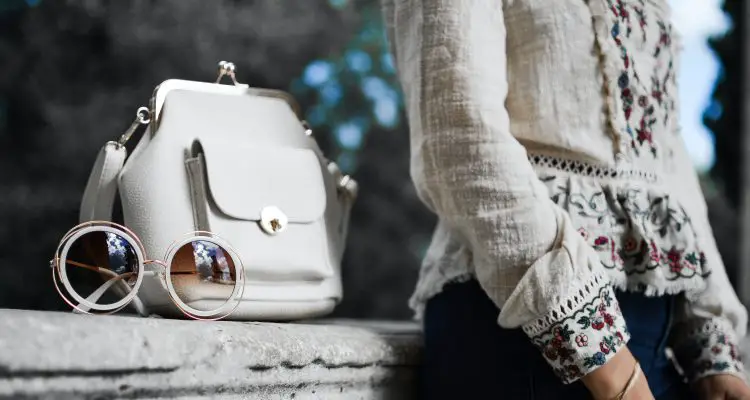You’ve probably heard of ‘fast fashion’ and its harmful impact on the environment. Now it’s time to put the spotlight on its antithesis: slow fashion. What is slow fashion, why should you support it, and how can you adopt it into your lifestyle?
Contents
The (Environmental) Crimes of Fashion
When you look at what’s in your wardrobe, it probably doesn’t cross your mind to think of how much of the earth’s resources go into creating a single shirt. But by now you already know that everything we do, create, and consume carries a carbon footprint. Our clothes are no exception. Take a look at these figures:
- The textile and clothing sectors contribute 10% of the world’s greenhouse gas emissions. In fact, the fashion industry’s carbon footprint is even greater than the airline and maritime industry combined.
- 20% of wastewater worldwide comes from dyeing and treating fabric. (A pair of jeans, for instance, consumes 3,781 litres of water from production to delivery.)
- Making polyester, a popular material for anything from scarves to shirts and jackets, consumes 70 million barrels of oil annually.
As if the list of fashion industry’s environmental offences isn’t long enough, along comes fast fashion.
What’s Wrong with Fast Fashion?

Fast fashion is a business model that, according to Study NY, “describes when companies imitate styles and trends seen on the runways at fashion week and recreate them at a much lower price and quality to sell to the mass market.”
While this sounds like a perfectly okay way to make high fashion accessible to the buying public, it is not without its evils. Here are a few:
1. Unsustainability
Twenty years ago, fashion houses and clothing brands only came out with new collections four times a year. Now, fast-fashion labels release new designs weekly. The surplus of cheap clothing flooding the market has encouraged overconsumption.
To counter overproduction and clear space for new stocks, some fast-fashion retailers even resort to burning and destroying unsold, perfectly usable products. The tremendous amount of resources this model entails is just environmentally irresponsible.
2. Waste
With the consumption of resources comes the production of waste. Each year, 80 billion new clothes are produced; sadly, only 20 percent of all clothes produced gets recycled. The 2018 Pulse of the Fashion Industry Report estimates that a garbage truckful of textile material gets dumped in landfills every second.
3. Worker exploitation
The collapse of an eight-story garment factory in Dhaka in 2013, which resulted in the death of 1,134 workers, is a tragic reminder of one of the grim realities of fast fashion, which is the sacrifice of worker welfare for the sake of profit margins and production quotas.
Forced overtimes, subpar working conditions, and below-minimum wages are just some of the realities garment workers in countries like India, Cambodia, and Bangladesh face just to satisfy our fashion fix.
In the same way that the slow food movement came about as a response to the waste and unhealthiness of fast food, a new movement emerged that seeks to undo all that is wrong with the fashion industry. Thus, the slow fashion movement was born.
Slow Fashion: Putting the Brakes on Fast Fashion
The term slow fashion can be credited to eco textiles consultant Kate Fletcher in a 2007 The Ecologist article. She describes slow fashion as “designing, producing, consuming and living better.”
Fletcher explains further: “Slow fashion is not time-based but quality-based (which has some time components). Slow is not the opposite of fast – there is no dualism – but a different approach in which designers, buyers, retailers and consumers are more aware of the impacts of products on workers, communities and ecosystems.”
How to Spot Slow Fashion Brands
Sustainability advocate Anna Lappé wrote, “Every time you spend money, you‘re casting a vote for the kind of world you want.”
As consumers, one of the ways we can contribute to positive change is by supporting slow-fashion brands.
How can you tell if a brand is truly slow fashion (and not merely a fast-fashion label hiding behind greenwashing)? Here are key characteristics to look out for:
1. Transparency
Fast-fashion brands like to keep the public in the dark about where they source their raw materials, who produce their products, where their facilities are located, and how much they pay for labour since this will potentially open them up to criticism.
Slow-fashion brands, in contrast, have nothing to hide and are in fact proud of the high standards they uphold. You can browse their website and readily find everything you need to know about their production process, workforce, supply chain, and pricing.
2. Local production
Slow-fashion labels usually make it one of their missions to support the local economy, never mind if it means paying more for labour and raw materials. This is in contrast to the usual practice of building facilities and outsourcing production to third-world countries to save on costs.
3. Quality over quantity
As Fletcher emphasised, “Slow fashion . . . takes the pressure off time.” Free from the demand of having to produce at high volumes and following a weekly production calendar, slow-fashion brands have slower production schedules and produce in small, limited batches.
Putting a premium on quality also means artisans handcrafting each piece and using sturdier materials, which explains why you have to pay more. But then again, quality means getting to use a piece for longer (and therefore not needing to buy as often), so you get your money’s worth.
4. Ethical labour practices
Slow fashion honours each person involved in the supply chain. Beyond seeing them merely as cheap labour, workers for slow-fashion brands are fairly compensated, work in a safe and healthy environment, and are given opportunities for educational, social, and career advancement.
5. Sustainability
Slow fashion respects the environment and seeks to be as low impact as possible. Look for brands that practice any (or all!) of these:
- Having carbon neutral operations
- Using organic and renewable materials
- Using minimal, recyclable or reusable packaging
- Encouraging customers to prolong the life span of what they buy via ‘take back’ schemes, care boxes, and repair or cleaning services.
Going Beyond: Slow Fashion as a Lifestyle
However, it’s worth keeping in mind that slow-fashion clothing, even if it’s sustainably or ethically made, still consumes the earth’s resources. There are ways to still be fashionable without having to buy brand-new, or even buy anything at all!
Here are some ways to make more meaningful, sustainable fashion choices:
- Make do with what you already have. You may have fast-fashion items in your wardrobe (from when you still didn’t know any better). You don’t need to ditch them or throw them out if they’re still perfectly wearable. Commit to using whatever you already have on hand, making sure to extend their life span by repairing and treating them with care.
- Buy second-hand. Thrifting and buying from consignment stores give clothes a second shot at life and save millions of previously unused garments and clothing from being discarded in landfills.
- Choose quality over quantity. Invest in timeless pieces that will outlast trends and seasons. Resist buying items that you’ll only use once or twice a year. (Check out our guide on creating your own capsule wardrobe).
- Adopt a minimalist mind-set. Living sustainably also means changing our spending habits. Rethink “retail therapy” (after all, its effects are only short-lived) and impulse buying. Ever heard the advice, “Never get caught wearing the same outfit twice”? Throw that outdated nonsense out the window! Be comfortable living with and owning less.
- Reuse and recycle. Never throw your clothing and footwear in the trash. Reuse, repurpose, and recycle, wherever possible. Cotton and polyester fabrics are easily recyclable. If your clothes are no longer sparking joy, consider giving them to friends or donating them to charity.
Change starts with you. It may seem impossible to take on big-brand retailers, but with enough of us committing to making better purchasing decisions, we can definitely make a significant impact.
Other Articles That May Interest You:
Fast Fashion: The Good, the Bad, and the Solution
5 Ways to Have a Greener Wardrobe?…
10 Sustainable Clothing Brands Worth Checking Out (and Why)


Leave a Reply